This entry is actually fulfilling a request made of me by a friend of mine, whom I was talking to when I got the idea for it. We were discussing popular snacks in Japan, and I went off into a tangent, like I do, and started going on about seasonal foods and the importance of traditional Japanese thoughts and aesthetics when it comes to eating, and she seemed interested to know more, in entry form.
Perhaps to shut me up and give me something to do, more than anything, though she specified that she wanted a lot of pictures, so I've gathered a lot of them. So while this entry will be photo-heavy, I'll try to keep the droning history lesson to a minimum (as much as I possibly can while getting the point across).
So please enjoy a brief synopsis of the thought process behind Japanese cooking, the significance of seasonal foods, and a multitude of photos depicting both, hopefully informing and entertaining you just as much as it makes you hungry!

First off, you might want to whet your appetite by checking out last year's New Year entry. Among other things, I touched briefly on the specific foods that are enjoyed during the festivities, as well as the symbolic meaning behind some of them. There's also a nice picture of a huge banquet platter. But if you thought that all the puns and intricacies of why you need to eat this food at this time was trite and confusing, I'm sorry to tell you that I didn't even scratch the surface on traditional Japanese food customs.
But let me explain a little about washoku to you. Literally meaning "Japanese food", the first kanji (和, wa), is the old name for Japan, and is thus taken to mean traditional Japanese food, capturing the spirit and look of the culture during this time. While I won't go into the history and cultural influences that shaped and changed the ideal meal throughout the years, it is important to note what it is exactly that is meant to be conveyed throughout the preparation, presentation, and eating of it.
No matter what period of Japanese history you look back on, the look and feel of traditional things has always, at its core, been the same. The traditional arts always use a vibrant and contrasting display of colour, distinctive lines that are interesting to look at, and a sense of lightness, elegance and minimalism. This concept can be seen everywhere:
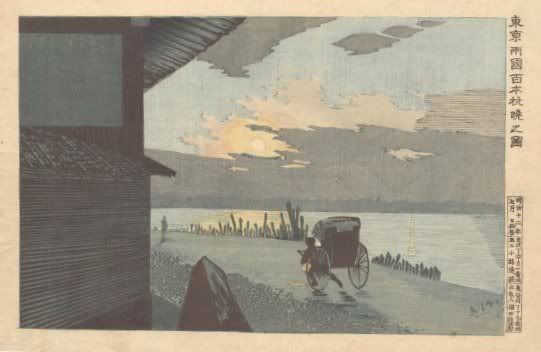
from woodblock prints,
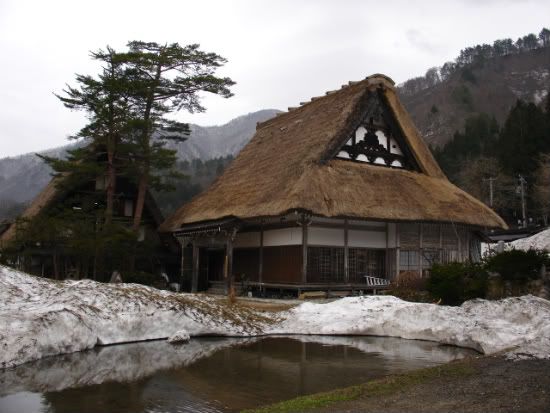
to architecture,
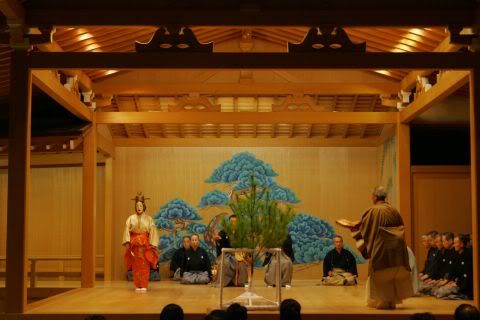
and classical theatre, just a few examples of the many different ways this ideal has exhibited itself over the years. And the driving force behind all of it of course lends itself to our food as well, complete with its very own culture and methods.

A traditional place setting following the fundamentals of washoku:
- a bowl each of soup and rice, placed on separate sides at the top of the serving
- a small plate containing fresh or pickled vegetables
- a long plate filled either with a singular long food or with three small servings of different foods across it
- chopsticks on a rest, facing to the left
- a focus on nature, expressed through the plates, decoration, and the food itself
This focus on nature is fundamental to the practices of washoku. A traditional dining experience should lend itself to the enjoyment of all five senses. For sight, the distinctive colours and appealing arrangement of not only the food, but the plates and dishes as well, which emphasises the natural decorations and favoured foods of the season. Smell is obviously taken care of by the cooking, or lack thereof, emanating from sauces, dressings, a combination of aromatic dishes, or the carefully preserved natural scent of the course alone. The sense of touch is appealed to by the bowls and dishes the food is served in. Even if you aren't eating finger foods, the chef will select the serving platters with care, not based solely on appearance, but which bowl would feel best when picked up, which cup has the most interesting texture, or, if not meant or able to be touched and picked up, which tray looks like it would feel nice, which table seems the sturdiest and conveys a sense of heaviness or craftsmanship, and so forth. During spring and summer months, new bamboo chopsticks are used, which provides the natural element of wooden implements which are light when held. During autumn and winter, lacquer chopsticks are often opted for instead, which are smooth and darker in colour and completely different to the touch, evoking a sense of warmth, in exactly the same way one opts to eat hot food when it's cold outside. Even sound is represented, anywhere from the location of the restaurant near a natural source, anything that gives a sense of one's atmosphere complimenting the food while eating, to the sound of a very fresh something being sliced, stirred, opened, bitten into.
All of this culminates and compliments the sense of taste, which is still treated as just another sense that needs to be satisfied by one's meal. This is most easily attributed to something called 旬, shun. It refers to seasonal foods, but is really an umbrella term for almost everything important in the presentation of a traditional Japanese meal.
One of the most interesting and culturally significant things about Japan is that it is a country with four distinctive seasons. Ask any Japanese person what their favourite season is, and why. The answer will almost always be because of a favourite food. (Mine is autumn, and it is for that reason.) Traditional dishes focus strongly on nature and one's place in it, and it is because of that, most seasonal foods are not served, preserved, or enjoyed out of the season they are freshest in.
To this end, the natural colours, flavours and appearance are carefully maintained. Any sauces are served on the side, and cooking is handled extremely lightly, if at all. The point of traditional cooking is only to compliment or enhance the original essence of the dish or singular item. Most Japanese restaurants, from the Edo period to the food culture enthusiasts of modern times, will often feature a menu centered around only one item. This item, however, can be served in a variety of ways, featured in dishes that play up different aspects of the colour, taste, season, or pairing it with other favourites that improve or compliment the food. For example, if your restaurant specialised in cooking sardines, you might have them prepared traditionally, dried, added to a soup with vegetables, or even paired with milk to soften the flavour and kill the fishy smell, to create a different dining experience for your patron.
While cooking in the washoku tradition (I'm aware that's redundant) there is a mnemonic device utilised to remember the different ways foods are popularly prepared. Since the focus is on seasonality and freshness, the philosophy goes that the most coveted dishes are those served as naturally as possible, the best way to experience the true taste and spirit of food. Fish, vegetables, and even meats are often eaten raw, or else seasoned very slightly. This is where the mnemonic device comes in (let's just call it a pun).
To explain: the Japanese alphabet, kana, is made up of a series of sounds, the vowels in order: a, i, u, e, o. These are also paired with a consonant sound, in this case, s. This leaves us with sa, shi, su, se, so, and this is the way to remember how to prepare food. They represent the order one should add seasonings to the dish, arranged from the lightest alteration to the original flavour, to the strongest. Defined,
sa - sato (sugar)
shi - shio (salt)
su - su (vinegar)
se - seoyu (shoyu, soy sauce. Yeeeeah, around here it basically skids off the track of easy remembrance and into expanding memorization to accommodate the pun, because damn it, this is Japan, and if puns had to make sense there would be no comedy duos at all, and then what the hell would we do with our afternoons?)
so - miso (miso soy bean paste, which is confusing and a stretch at best, but at least it's not seoyu.)
Focusing on one key ingredient, and preparing it faithfully while experimenting with different regional dishes and cooking methods to preserve the flavour, but explore different parts of the palate, is basically the entire purpose of the wonderful 90s cooking competition show, Iron Chef.
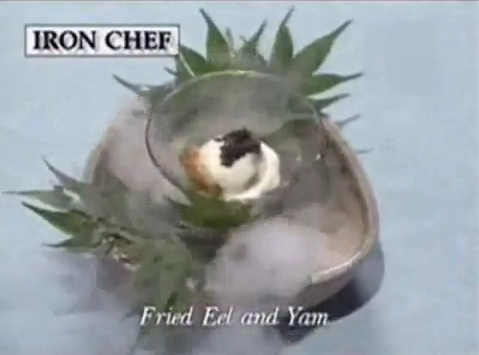
Here, Iron Chef Michiba has capitalised on the all-important "served elegantly in a bowl smoking with dry ice or something" visual for his eel and yam dish.
But enough about that. Now, for the main course!
! FOOD PHOTOS !
Keeping it as simplistic as possible, in the spirit of washoku, I'll just briefly touch on the essentials of each season, followed by many examples of my favourite dishes, foods, and presentation trends, all expressed in glorious high-definition photos.
Please click on the pictures directly in order to see the original gigantic-sized images, and enjoy a close-up look at real Japanese food!
SPRING
Springtime in Japan lasts from February through April, and is the most popular time for seasonal decorations, foods and other cultural-type things. Spring is extremely important, representing birth, growth, new starts, freshness, emerging from the darkness of winter, things like that. The cherry blossom tree is a cultural symbol of Japan, as I'm sure everyone knows about the flower-viewing festivals, multitude of motifs featuring the buds, countless songs, poems and works of art, or a number of any other traditions involved. The meaning and imagery behind the cherry blossom tree, impossibly beautiful flowers bursting into bloom before just as quickly succumbing to death and fluttering down in the wind is a pointed metaphor, not just in Buddhism and the zen way of life, but deeply ingrained into the Japanese spirit as well. But, while it provides a fine example and is quite well-known, it is hardly the only important seasonal emblem, much how sushi is not nearly the main staple of Japanese food and cooking. Sure, cherry blossoms and sushi run rampant in fancy hotels serving traditional seasonal fare, but sushi as it is served today is still a relatively new addition to Japanese food, and one can only throw so many cherry blossoms into their decorations before just moving a full-grown tree right into the dining area.
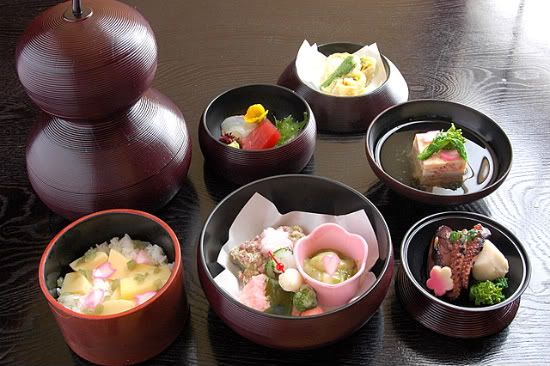
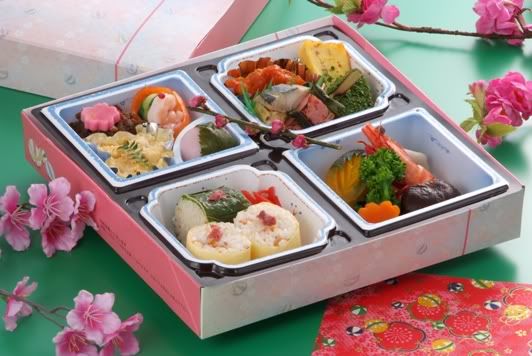

During spring, the overall taste, appearance and selections of ingredients focus on items that are new, young, simple, and extremely fresh. Throughout the desolation of winter, fresh ingredients are definitely something to look forward to. Sprouts, plant buds, young vegetables and fish all bear a light, sweet, or slightly bitter taste to bring the taste-buds back from the perceived slump of the long, cold months.

Pickled vegetables have always been added to meals, but the strong taste of new vegetables pickled is probably most popular in the spring. Mustard leaves and flowers, cabbage, asparagus, and many other crispy vegetables are popular spring pickles. My favourite is pickled turnip leaves.
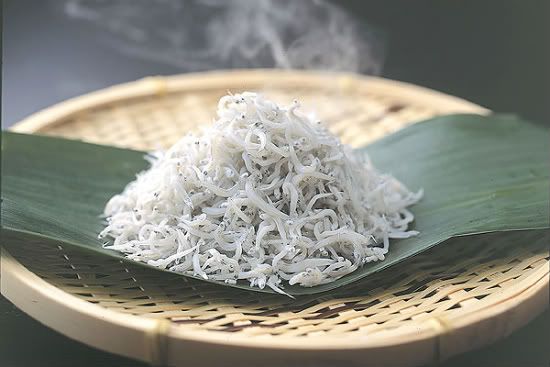
These are sardine fries (babies) that are dried and have a light, crispy and interesting texture. Most shun ingredients have popular pairings with other foods, but the toppings, additions and other spices or flavourings depends entirely on the chef, region, or even family who is making the food. A simple recipe that my family enjoys pairs the dried shirasu with the delicate and opposing texture of grated daikon radish, garnished with lemon and soy sauce (seoyu).
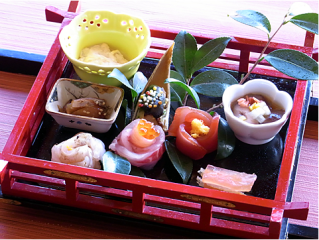
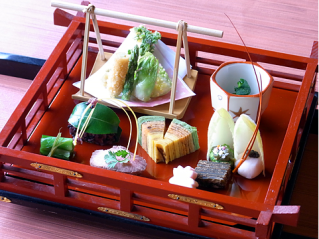
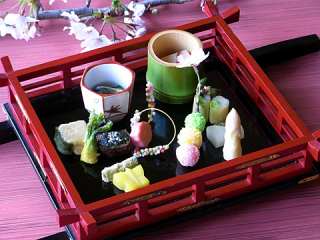
The springtime meals served at a hotel by month. Can you guess which month the cherry blossoms bloom in? Cherry blossoms are featured everywhere in washoku in the spring. From decorative bowls and plates, sprigs and branches of the trees themselves, cut-outs shaped and coloured like the blossoms, to even putting the petals directly into the dish, you can almost always tell which season the meal is prepared for, whether you know of the other ingredients being served or not.
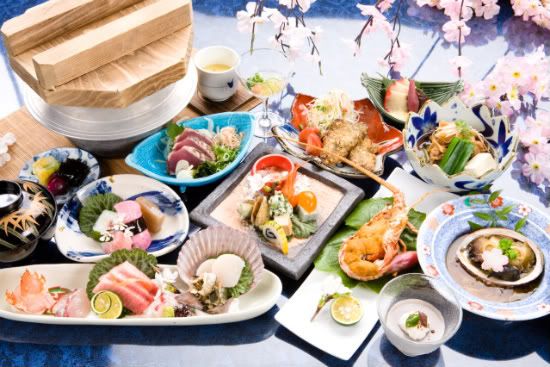
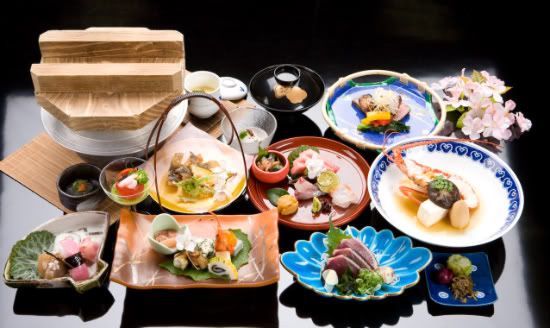
SUMMER
Summer in Japan lasts from May through July. It is the most bountiful season, with most fruits and vegetables producing at this time, the ocean overflowing with delicious seafood, and the like. The dishes are as bright and colourful as the summery meals served on them. Food is kept light and cool, in order to keep the body light and cool. Besides the sweltering heat that is a traditional part of the Japanese summertime, it is just as traditional to complain about it, and do as little as possible to avoid exhaustion. While we aren't all delicate court ladies and gentlemen anymore, much care is still taken to keep the seasonal summer foods appearing fresh, non-heavy and chilled, even if they aren't, like summertime soups and cooked rice with fresh vegetable dishes, for example.
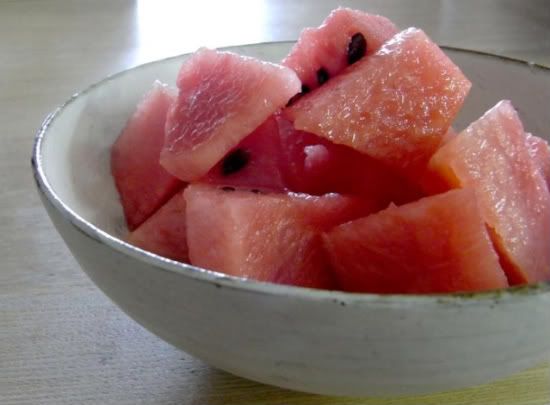
Many foods are served cold however, like melons, gourds, and other fruits and vegetables. The overwhelming summer favourite is chilled watermelon.
Most soups and noodles will be served cold, as well. One of the most exciting things to do in summer is get nagashi somen.

Somen are a type of noodle, though many other noodles can be substituted. Several restaurants will serve nagashi somen, meaning flowing somen, by constructing a series of bamboo chutes running with icy water, which the noodles are sent cruising down, to be plucked out by the diner himself, dipping the somen in sauce or mixing it with other ingredients in their bowl, and eating them right away. You can also sometimes get flowing somen at festivals or other special occasions in summer, who might hire someone to construct the flumes and serve flowing somen. It's a very rare treat.

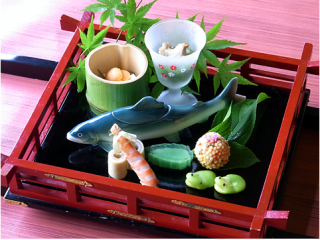
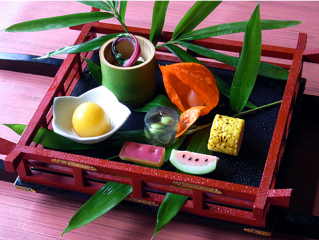
The summer menu from same hotel as above. As you can see, many of the dishes they opted to use are made of glass. The frosted look of the glass suggests the appearance of ice, which capitalises on the sense of sight to trick the body into thinking it is ice, and cool itself down.

Glass tableware should not be used outside of a hot summer day. While making yourself feel cold and comfortable in July, looking at it in the dead of winter will have the opposite effect, making you feel frozen and uncomfortable.
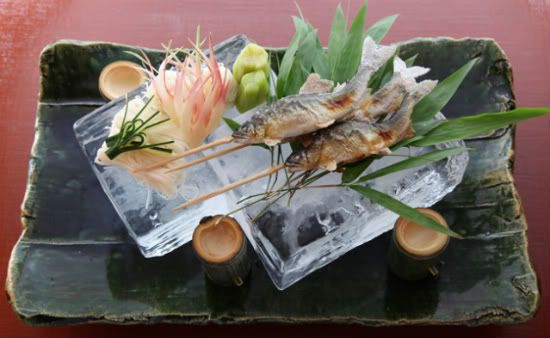
This meal is served on actual ice. Appearing sleek, elegant and expensive, the fish also make me feel cold just looking at them, which, as appetizing as it is, makes me feel even colder since it's February now.
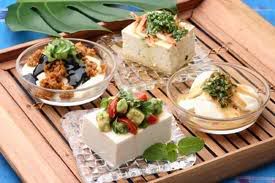
My favourite dish for summer is hiyayakko, chilled tofu with toppings. Like shirasu, the toppings depend on where you are and what you personally prefer. Most often, I eat it with fresh green onion, grated ginger root, panko, and shoyu. The photo shows several different toppings and sides that can accompany hiyayakko.
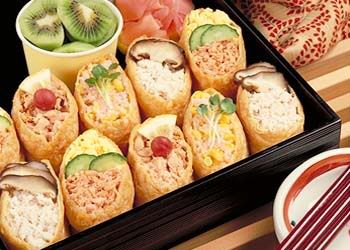
The only sushi I'll talk about, it's very different from most people's idea of sushi. Sushi in fact refers specifically to the vinegared rice, and raw fish, seaweed or other common toppings aren't necessary at all to qualify something as sushi. This sushi is called Inarizushi, a deep-fried pouch made of tofu filled with the sushi rice, though the rice itself isn't sugared like normal sushi rice. Instead, it is left slightly sour from the vinegar and salt, while the tofu is prepared sweetened to culminate in a very interesting taste when eaten. Several popular toppings are shown above, in addition to carrots, avocado, hot chili mayonnaise, and chopped greens or seaweed. My favourite fillings are black sesame seeds and spicy mustard.

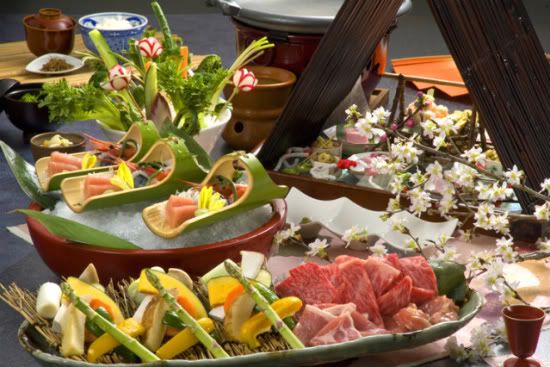
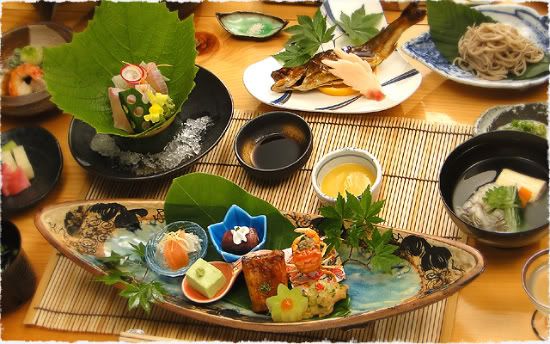
AUTUMN
In Japan, autumn lasts from August through October. In my opinion, seasonal Autumn foods are the best and most flavourful examples of shun. Mushrooms, eggs, chestnuts, rice and soba buckwheat noodles are most often enjoyed. Dishes and bowls are earth-coloured and look very natural and appealing. Just as the blooming flowers of spring are enjoyed, the opposite here, the many colours of autumn as leaves wither and die are just as poignant and appreciated. Bright red leaves from Japanese maple trees are featured prominently as decorations and cut-outs.

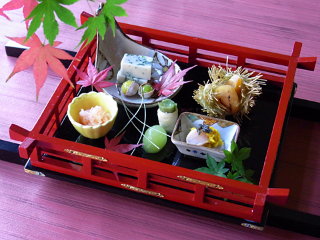
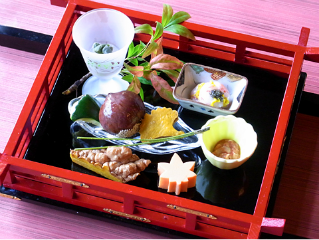
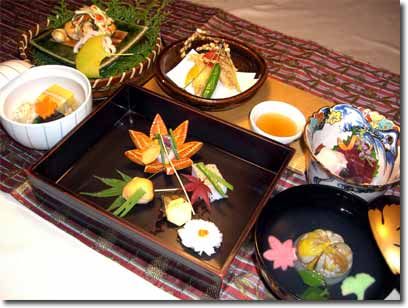

Mushrooms are probably the best thing you can have. Many different types of Japanese mushroom are often used in any meal made especially to capture the autumn season. The most expensive delicacy must be the matsutake, a huge mushroom prized for its aroma, which captures the feeling of autumn perfectly. At least, it should, seeing as the large ones usually go for $200 per mushroom.

$1000. Basket not included.
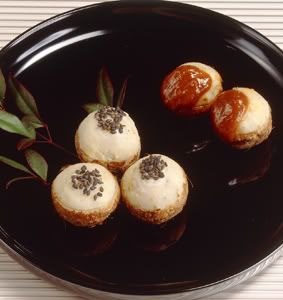
Vegetables include lotus root and potatoes. One of the most popular treats is the satoimo, a type of potato with a very unique texture.
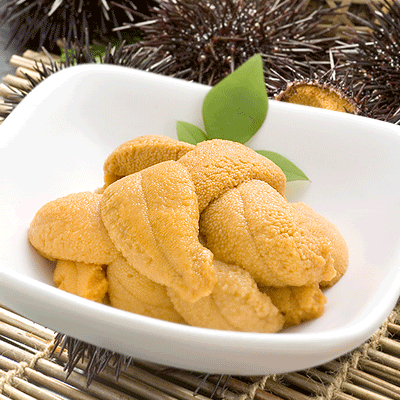
Another fancy treat is uni, sea urchin roe, a bright autumn-leaf coloured caviar with an equally unique texture. It is a very acquired, and expensive taste. You rather get the feeling of licking the bottom of the ocean, but if that's your thing (I LOVE SEAFOOD), uni is wonderful to have.
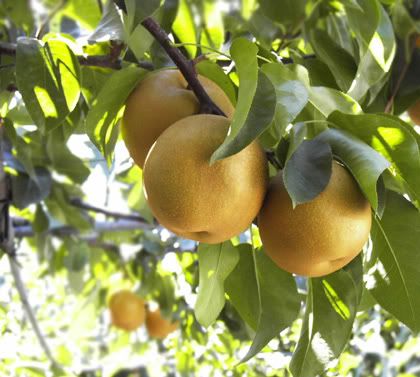
Autumn fruits are probably the thing I look most forward to. Bitter, sour and available for such a short time, it's one of the things that makes autumn my favourite season. Many watch for the cherry blossoms and that first sign of spring, but my moment is when I realise that I can eat nashi, a crispy, delicious type of pear only available for a little while, and it's officially autumn for me.
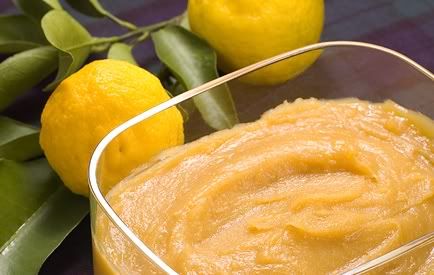
Yuzu is another popular fruit during autumn. A sour citrus fruit, they are often cooked with miso, or even mixed into miso, to make... wait for it... yuzu miso, a most delicious thing.
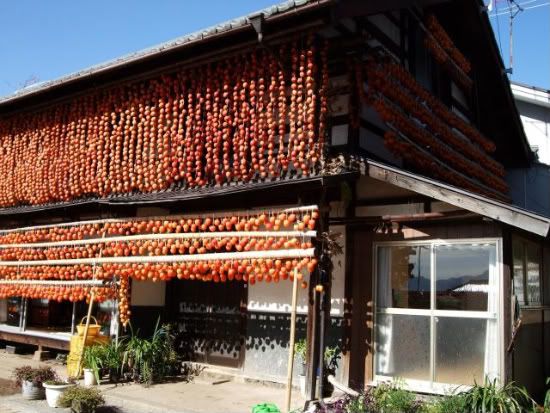
Perhaps the most well-known is the persimmon. Persimmons have a very limited availability in this season, and, if not eaten just at the point of ripeness, can taste extremely bitter or become overly mushy and inedible. So shun plays a very big part with the persimmon. They are featured at very nice restaurants and banquets, because it's not something you can just keep around and use to garnish something at the last minute. Almost all 'garnishes' are meant to be eaten in Japan, and nobody wants to bite into a rotten persimmon. So these fruits are very prized to enjoy in the autumn season. The number one way to have a persimmon, however, is hoshigaki. Hoshigaki literally means dried persimmon, and they are prepared in a very special manner. Each persimmon is peeled and carefully manipulated by hand to preserve the natural flavour, and strung up to dry. The long curtains of lantern-shaped peeled fruit hanging from the eaves of farmhouses is a treasured sight and, like nashi, another of my favourite things that signifies autumn.

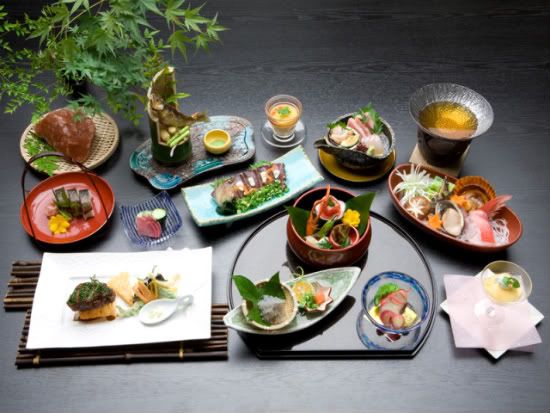
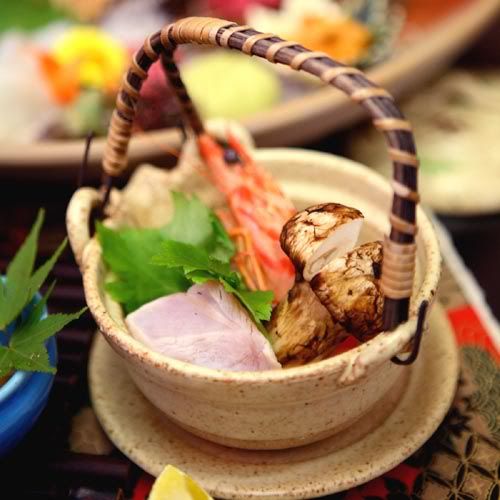
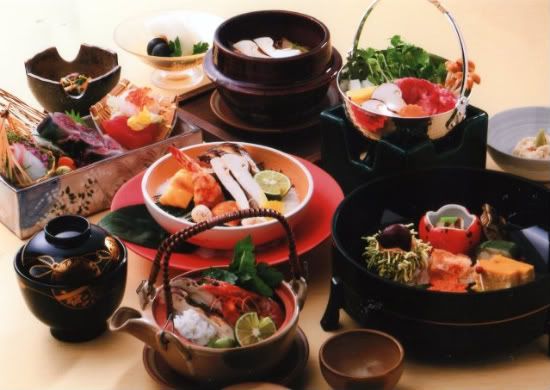
WINTER
Winter in Japan lasts from November through January. Of course, many specific seasonal foods are prepared and enjoyed exclusively on or around the New Year, but I won't go into that. There are just so many tiny reasons and puns and things to be enjoyed for the first time on New Year, the most important holiday, but year-round there are still more festivals and foods meant to be enjoyed only around that time, or only at the beginning, middle, or end of each season. Not just at New Year, but each season has its own set of firsts and whens to have and experience and eat. So I will focus on foods to be enjoyed throughout winter on its own as a season, and not for the holidays that fall in with it. Spring and autumn focus on the cycle of nature, gradual birth and slow fade, and summer and winter correspond as well, representing full life and extreme death. Like the overwhelming heat of summer is constantly bemoaned, so too is the (perceived or not) horrific, freezing cold of winter, and the long famine of all good food and taste is something one must painfully slog through until spring, which makes that first bite of springtime cuisine that much more amazing. But winter isn't all bad! There are plenty of good dishes to be appreciated as well. Granted, it is often very cold, and almost all dishes are heavily cooked, served warm, and stewed together, something that takes a way a bit from the individual shun flavour of each ingredient, but they're still appetizing.
Thoughts of being warm, hot, steaming food, and the tastes of winter are to be focused upon. Stews and other nabemono are served in heavy earthenware pots, simple ingredients are arranged carefully in dark lacquer, emphasizing the feeling of staying warm, and the overall patterns and colours of the serving plates and bowls are kept muted, matching the quiet, resting sense of winter. Fresh vegetables are available, but are mostly limited to the root variety. Noodles and soups are also heavily featured.
My all-time favourite type of noodle is udon, the thickest kind. They have the best texture and taste to me. During winter, they are served in a variety of broths with an even larger variety of ingredients. The type of ingredients you put in your udon soup is once again dependent on your region and personal preference, but since so many different types of noodle soups are made, many ingredients are added especially and named after them.
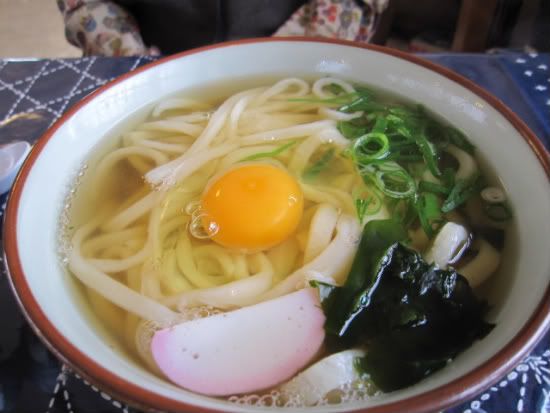
This type, which my family refers to as "mountain-style", is my most favourite of them all. As you can see, it features seaweed, green onion, kamaboko fish-cake and a raw egg, which cooks ever so slightly in the hot broth. It is delicious. Other popular additions are vegetable or seafood tenpura. Tenpura flakes (the fried batter with no insides) are added to tanuki udon, suggesting that the mischievous tanuki has played a trick by swapping your tenpura with the drippings. Fried tofu pouches can also be included to make kitsune udon, the favourite of the equally-mischievous foxes who are associated with the Kami Inari (who also like Inarizushi in the summer, naturally).
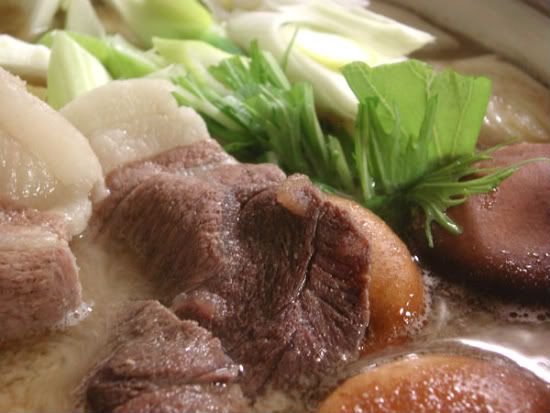
Botan-nabe is one of the many varieties of meat stews enjoyed in the winter. Hearty and substantial, various cooked meats, fish, and vegetables are prepared in soup, stew, or hot-pot form. Deer, boar, horse, cow, and deep-sea fish are the most popular. Botan-nabe features boar meat.
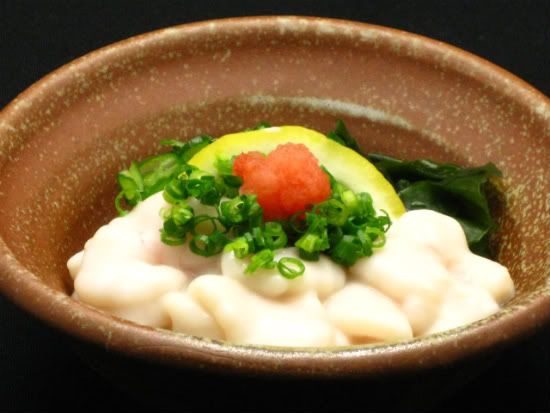
Blowfish and pufferfish (the deadly fugu) are also popular in stew. Not only that, but the entirety of the fish is prepared in many different ways. Several parts of the fugu are eaten, and it is extremely well-known in Japanese cuisine because of the toxicity. Several parts of the fugu are poisonous, and, if the poisoned areas are not removed properly, can affect the edible bits and cause death. Therefore, eating fugu is often seen as a popular rite of passage, risking one's life to sample the deadly fish. In actuality, it's more of a celebration of the precise and amazing skills of the chef preparing it, which is clearly a more washoku way to look at things. To be honest... fugu isn't really all that tasty. At least, in my opinion. But that photo above is the one I would just sit and stare at sometimes while working on this entry. The soft roe of the fugu or cod (cod here) is an extreme delicacy, and highly sought-after. In preparation, the white soft roe is meant to taste and appear in the bowl like a cloud.
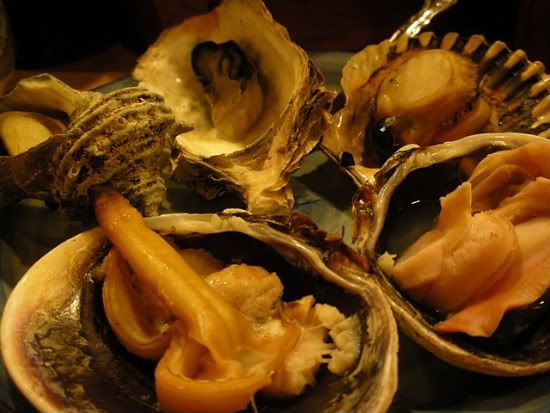
Here we see another seafood dish for wintertime. Shellfish are prepared, and even sometimes made into a mixture of assorted seafood and other ingredients, and cooked hot within the shell.
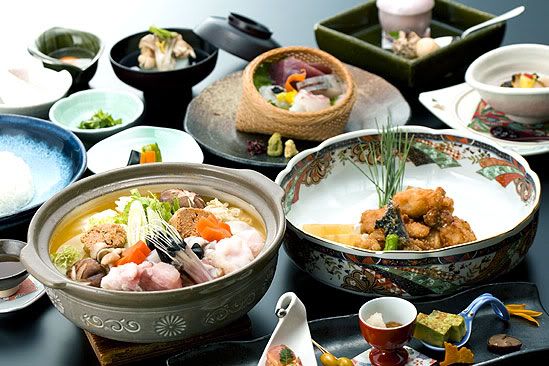
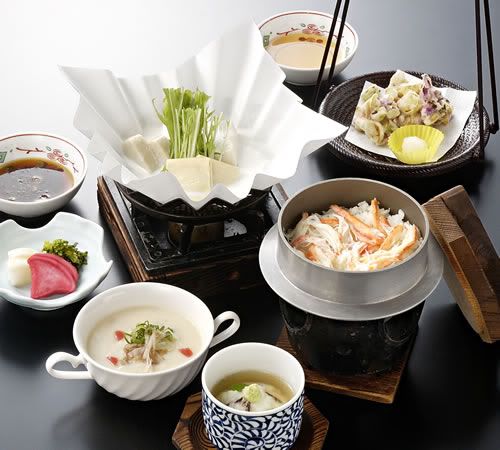
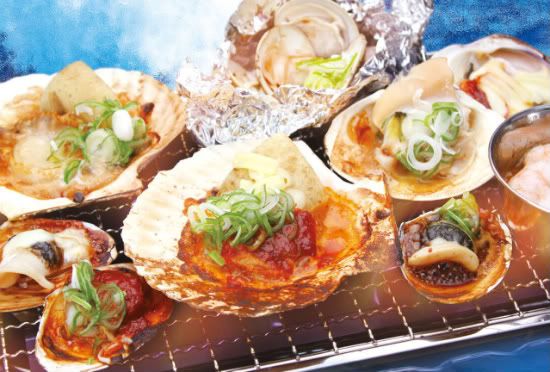
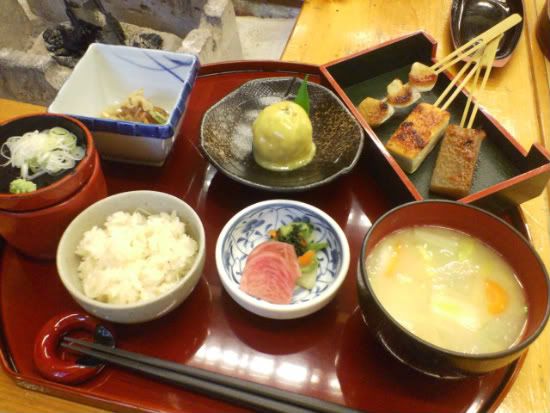
So now you know all about washoku, shun, and several of my favourite types of Japanese food. Hopefully it was as informative and appetizing as it was long, I didn't mean to go on so much, but I got extremely hungry while working on this, and kept thinking of many other things to include that I liked to eat. So I'll stop now, before I pass out from the hunger, and see you very soon with a new entry!!
Special thanks goes to my friend Lucy, for requesting the entry against her better judgement. I am also indebted to the invaluable information provided me by my friends, qualified washoku chef Lo, and his girlfriend who, unlike me, spent her seasons in Japan eating at fine traditional restaurants instead of ピザハット.
No comments:
Post a Comment